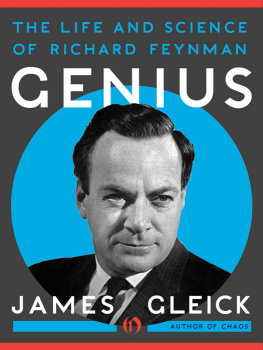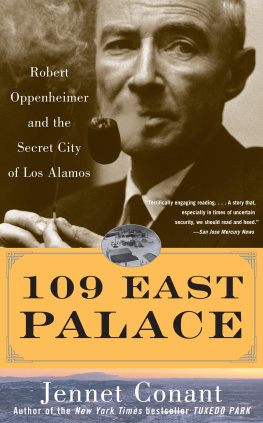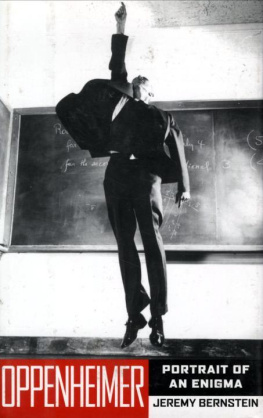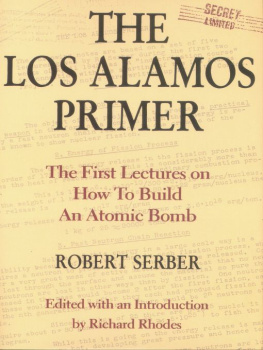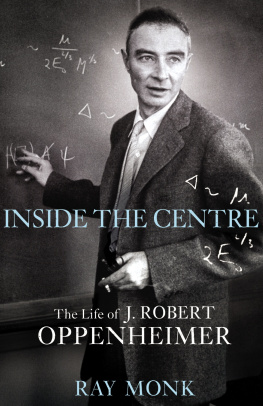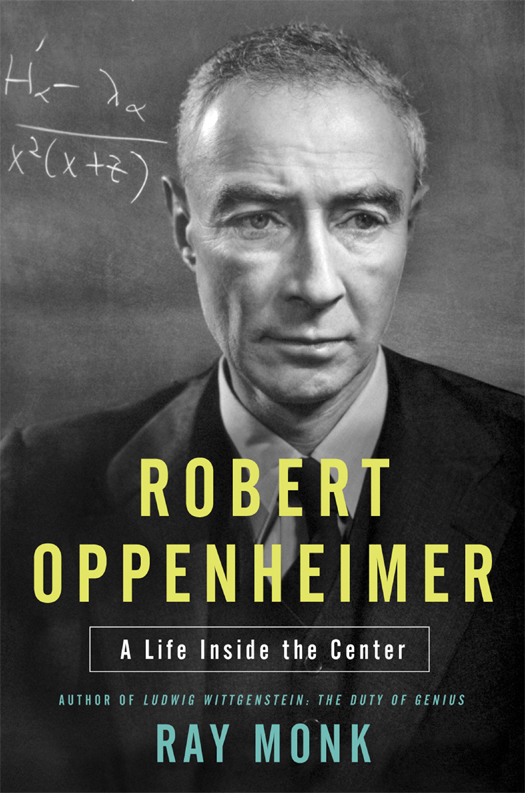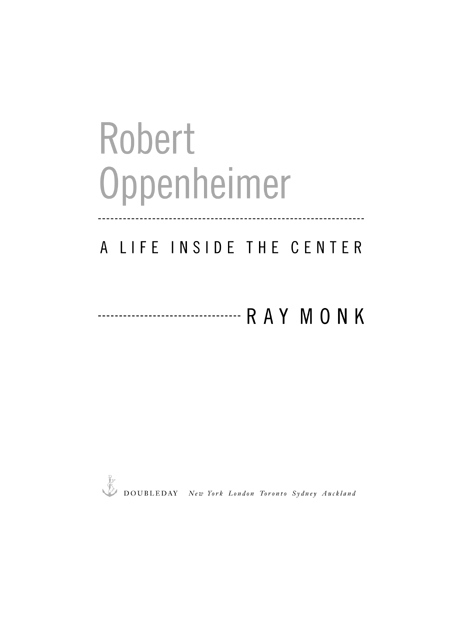ALSO BY RAY MONK
How to Read Wittgenstein
Bertrand Russell: The Ghost of Madness, 19211970
Bertrand Russell: The Spirit of Solitude, 18721921
Ludwig Wittgenstein: The Duty of Genius
Copyright 2012 by Ray Monk
All rights reserved. Published in the United States by Doubleday, a division of Random House, Inc., New York, and in Canada by Random House of Canada Limited, Toronto.
www.doubleday.com
Originally published in Great Britain as Inside the Centre: The Life of J. Robert Oppenheimer by Jonathan Cape, a division of The Random House Group Limited, London, in 2012.
DOUBLEDAY and the portrayal of an anchor with a dolphin are registered trademarks of Random House, Inc.
Jacket design by Emily Mahon
Front jacket photograph Corbis
Spine photograph The Granger Collection, NYC
eBook ISBN: 978-0-385-50413-3
Hardcover ISBN: 978-0-385-50407-2
Library of Congress Cataloging-in-Publication Data
Monk, Ray.
Robert Oppenheimer : a life inside the center / Ray Monk. First U.S. edition.
pages cm
Includes bibliographical references and index.
1. Oppenheimer, J. Robert, 19041967. 2. PhysicistsUnited StatesBiography. 3. Atomic bombUnited StatesHistory20th century. 4. PhysicistsUnited StatesIntellectual life20th century. I. Title.
QC16.O62M66 2013
530.092dc23
[B] 2012046045
ISBN 978-0-385-50407-2
v3.1
Contents
List of Illustrations
First Insert
Oppenheimer with his mother ( Historical/CORBIS)
Oppenheimer in the arms of his father ( Historical/CORBIS)
Oppenheimer building with blocks ( Historical/CORBIS)
155 Riverside Drive ( Milstein Division of United States History, Local History and Genealogy, The New York Public Library, Astor, Lenox and Tilden Foundations)
Oppenheimer at Harvard ( Harvard University Archives)
William Boyd ( The National Library of Medicine)
Paul Horgan ( J. R. Eyerman/Time & Life Pictures/Getty Images)
Frederick Bernheim (image provided by the Duke Medical Center Archives)
The Upper Pecos Valley (courtesy of the Palace of the Governors Photo Archives, New Mexico History Museum, Santa Fe/053755)
Inside the Cavendish Laboratory, Cambridge ( Omikron/Science Photo Library)
Paul Dirac ( Bettmann/CORBIS)
Patrick Blackett ( Science Photo Library)
Niels Bohr ( Lawrence Berkeley Laboratory/Science Photo Library)
Max Born ( Bettmann/CORBIS)
Charlotte Riefenstahl ( Gttingen Museum of Chemistry)
Werner Heisenberg ( Bettmann/CORBIS)
Paul Ehrenfest
Oppenheimer on Lake Zurich with I. I. Rabi, H. M. Mott-Smith and Wolfgang Pauli ( AIP Emilio Segr Visual Archives)
Oppenheimer at Berkeley (courtesy of the Department of Physics, Physics and Astronomy Library)
Oppenheimer with Robert Serber ( New York Times/Redux/eyevine)
Ernest Lawrence ( AIP Emilio Segr Visual Archives)
Kitty ( Historical/CORBIS)
Perro Caliente ( Peter Goodchild)
Haakon Chevalier (courtesy of The Bancroft Library, University of California, Berkeley)
Frank Oppenheimer
Jean Tatlock ( Dr. Hugh Tatlock)
Steve Nelson ( United Press International Photos)
Joe Weinberg, Rossi Lomanitz, David Bohm, and Max Friedman
The staff of the Radiation Laboratory in Berkeley ( Science Source/Science Photo Library)
Second Insert
Julian Schwinger ( Estate of Francis Bello/Science Photo Library)
Richard Feynman ( Tom Harvey)
The Los Alamos Ranch School ( Digital Photo Archive, Department of Energy [DOE], courtesy AIP Emilio Segr Visual Archives)
General Groves ( Los Alamos National Laboratory/Science Photo Library)
Enrico Fermi ( Argonne National Laboratory/Science Photo Library)
The graphite pile at Stagg Field ( Historical/CORBIS)
Hans Bethe ( Science Source/Science Photo Library)
Klaus Fuchs ( Keystone/Time & Life Pictures/Getty Images)
Edward Teller ( University of California Radiation Laboratory/Science Photo Library)
Seth Neddermeyers early attempts at implosion (courtesy of the Los Alamos National Laboratory Archives)
The Nagasaki and Hiroshima bombs (Claus Lunau/Science Photo Library)
The Little Boy design, as reverse engineered by John Coster-Mullen
Workers at Oak Ridge ( Oak Ridge National Laboratory and Digital Photo Archive, Department of Energy [DOE], courtesy AIP Emilio Segr Visual Archives)
Preparing the Trinity Test (courtesy of the Los Alamos National Laboratory Archives)
The Trinity explosion ( Historical/CORBIS)
Oppenheimer and Groves at the Trinity Test site (Emilio Segr Visual Archives/American Institute of Physics/Science Photo Library)
The effects of the atomic bombs in Japan (courtesy of the Los Alamos National Laboratory Archives)
Oppenheimer and Kitty in Japan, 1960 ( Historical/CORBIS)
The cover of the first issue of Physics Today (courtesy of Berkeley Laboratory)
Albert Einstein and Leo Szilard ( Time & Life Pictures/Getty Images)
)
The Mike Test
Oppenheimer lectures Ed Murrow ( Bettmann/CORBIS)
Oppenheimer with Paul Dirac and Abraham Pais at the Institute for Advanced Study ( Alfred Eisenstaedt/Getty Images)
Oppenheimer, Toni, and Peter at Olden Manor, Princeton ( Alfred Eisenstaedt/Time & Life Pictures/Getty Images)
Lewis Strauss ( Bettmann/CORBIS)
Edward Teller congratulates Oppenheimer on his Fermi Prize ( Ralph Morse/Time & Life Pictures/Getty Images)
Oppenheimer speaking at last visit to Los Alamos ( Oppenheimer Archives/CORBIS)
Oppenheimer photographed for Life magazine ( Time & Life Pictures/Getty Images)
Preface and Acknowledgments
The origins of this book lie in a review I wrote about fifteen years ago of a reissued edition of Robert Oppenheimer: Letters and Recollections, edited by Alice Kimball Smith and Charles Weiner. Until then, I knew about Oppenheimer only what everybody knows: that he was an important physicist, that he led the project to design and build the worlds first atomic bomb, and that he had his security clearance taken away from him during the McCarthy era because of suspicions that he was a communist, or even possibly a Soviet agent.
What I did not know until I read this collection of his letters was what a fascinatingly diverse man he was. I did not know that he wrote poetry and short stories, that he had a deep love and wide knowledge of French literature, that he found the Hindu scriptures so inspiring that he learned Sanskrit in order to read them in their original language. Nor did I know how complicated and fragile his personality was, nor how intense his personal relations were with his father, his mother, his girlfriends, his friends and his students.
Learning all this, I was surprised to discover that no full and complete biography of him had, at that point, been written. There was, I said in my review, a really great biography waiting to be written about Oppenheimer, a biography that would attempt to do justice both to his important role in the history and politics of the twentieth century and to the singularity of his mind, to the depth and diversity of his intellectual interests. Such a book would need to describe and explain his contributions to physics and to place them in their historical context. It would need to do the same with regard to his other intellectual interests and to his participation in public life. It would not be an easy book to write. In fact, it seemed perfectly possible that it would never be written.



